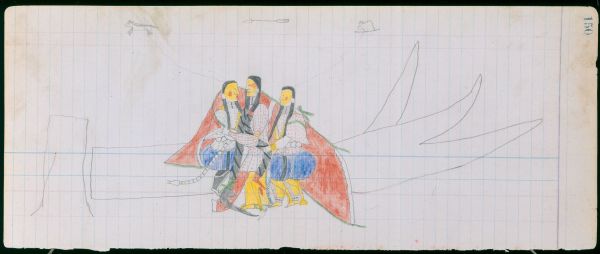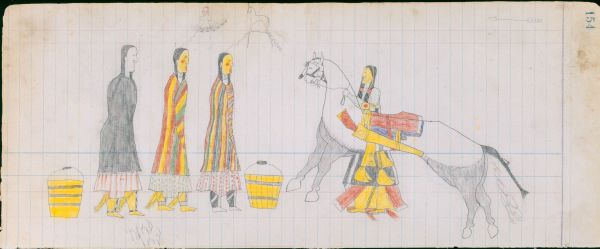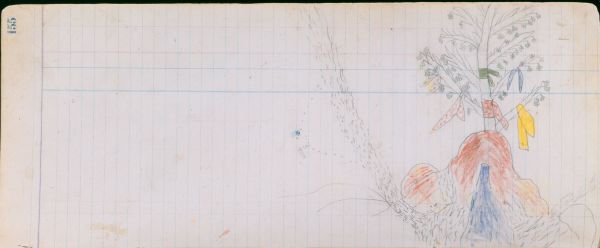PLATE 150
Ethnographic Notes
"...an unmarried woman must never be found alone, and it would be the height of impropriety for her to go anywhere with any man except her father. They are exceedingly fond of gadding about, and easily overcome the difficulties thrown in their way by custom. Half a dozen girls and young married women will place themselves in charge of some old lady friend, under whose chaperonage they go when and where they please, and usually with perfect safety" (Dodge, 1882: 345).
These two women are certainly Nisson relatives, who are chaperoning EACH OTHER. Just as with male Cheyennes, a woman's closest friends and her co-conspirators in adventures of the heart would be her sisters and female cousins. For a ca. 1885 photograph of two such Cheyenne women, which compares very well with Arrow's drawing, see Cowdrey, 1999: Fig. 54.
The locale, on a fallen cottonwood trunk, suggests that they may officially (as far as their parents know) be out gathering wood. It is not their fault that this handsome guy just happened to be sitting on the best wood-gathering source in the neighborhood. Alibis are always important, whatever the culture. This coincidental meeting, however, has all the earmarks of a well-executed plan.
The central name glyph leaves no doubt that the object of their affections is none other than the artist, whose neck is about to suffer whiplash because he has devoted three seconds more attention to one sister than the other. The lady who (briefly) is receiving Arrow's undivided attention is probably Hone-nish-e-ots-ohm "Woman Going With Two Wolves", whose name appears on the 1880 census of the Cheyenne-Arapaho Agency, Family #380 (Oklahoma Historical Society, Microfilm CAA 4). The name of her sister probably is Vosta me-ene, "White Buffalo Cow Coming Into View" (Petter, 1915: 49 & 734), or "White Cow Appearing".
A visitor to Darlington Agency in 1883 describes the Southern Cheyennes:
"Every woman and girl's hair was well oiled and braided into two strands, one on each side of the head, with the parting line marked with vermilion...Sometimes the cheekbones were outlined in red, sometimes in yellow. Others contented themselves with a single vermilion dot...on the cheek below the eye..." (Collins, 1928: 57).
Each of the sisters here wears a spotted calico dress, with a belt of nickel-silver conchos around her waist. The belt on the left has a decorative leather "drop" laced with smaller conchos. All of these silver attachments may have been further ornamented with stamped or rocker-engraved designs.
White Cow Appearing wears bracelets of polished brass. Probably her sister does also, though her wrists at the moment are out of our view as she explores Arrow's ribs. Both women wear chokers of dentalium shells, and brass-bead necklaces with packets of herbs attached at the back of the neck. They probably obtained these mystical sachets from the same source as Arrow and his comrade---from Glad Road, the halfman-halfwoman. Preparing and selling such fragrances was one source of income for the He'emaneo. Note that Glad Road also wears one of these, in Plate 148---in the female form of a necklace, rather than the male style of bandolier.
The sisters wear identical, blue wool blankets. One suspects their father learned long since not to display any favoritism in gifts to his daughters. The single, significant variation in the dress of these sisters is in their footwear. White Cow Appearing has boot-moccasins of yellow-painted leather, with beautifully beaded cuffs. Her sister wears undecorated moccasins, with leggings of dark blue (shown as black) wool trade cloth. It is possible these leggings were also attached, to form boot-moccasins.
Arrow wears the same, yellow-painted leather leggings with blue-painted fringe, and the same otter fur hair wraps seen in Plates 138 & 144. His unbeaded moccasins are simply painted yellow, with green-painted fringe down the instep, and at the heel. Arrow's shirt is probably made of the finest silk, and he has chosen to accent his masculinity by wearing an extra-long, red wool breechcloth. He has brought along his double-width courting blanket of the same material---just in case any sisters should happen to walk by his fallen tree in the woods. The edges of this blanket are bound and accented with green silk ribbon. This appears to be a different blanket, as we should expect, than the one he gave away when the Kit Fox Society honored him in Plate 94---that one had blue binding. But he has chosen the same, "dress up" face paint he wore then, and for another courting excursion in Plate 88.


